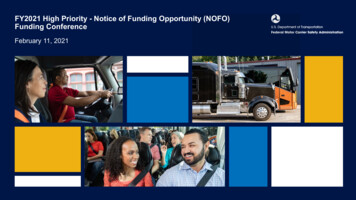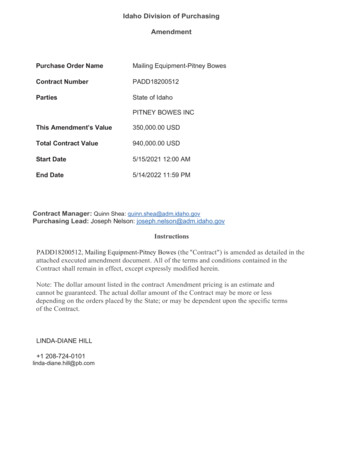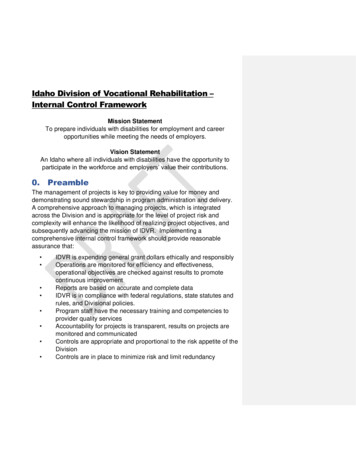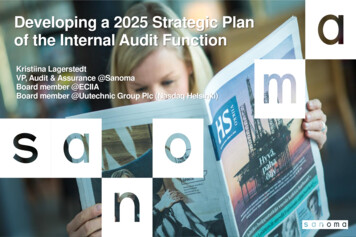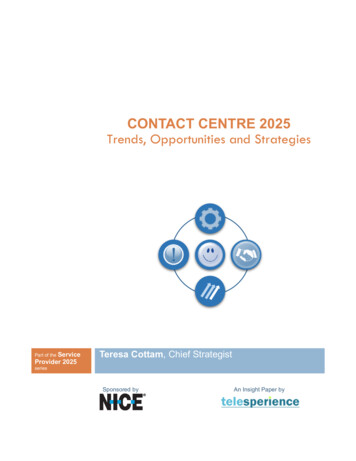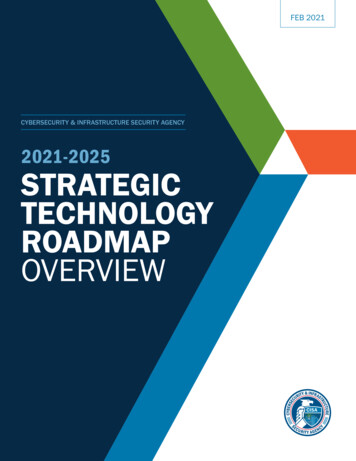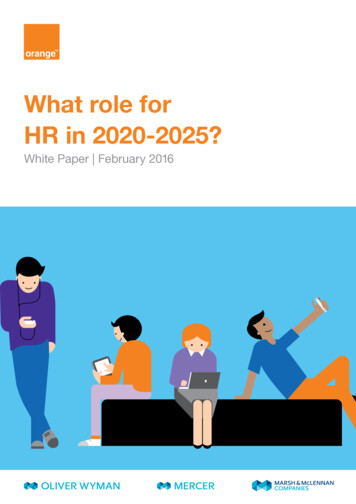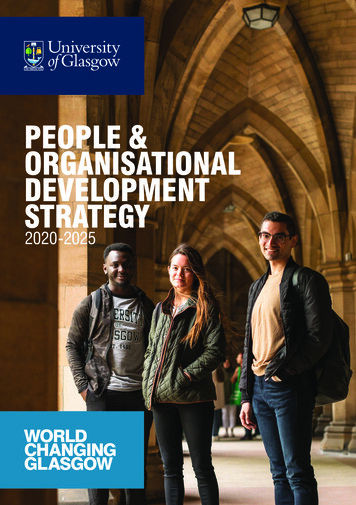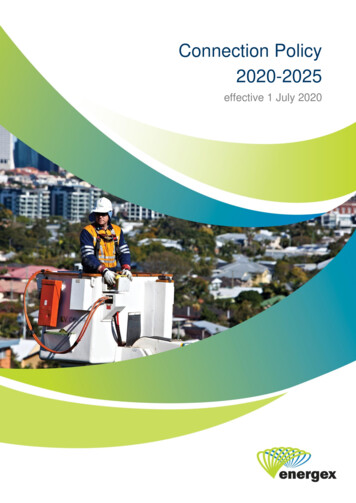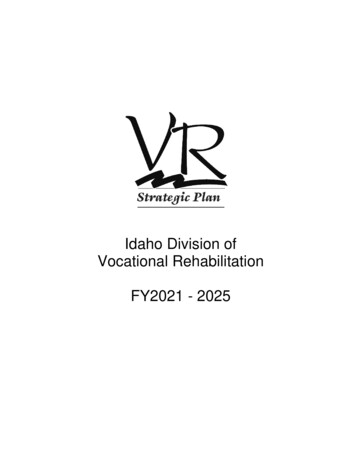
Transcription
Idaho Division ofVocational RehabilitationFY2021 - 2025
Content and FormatThe Plan is divided into four sections. The first three sections describe the programsadministered under the Idaho Division of Vocational Rehabilitation (IDVR). Each of theprograms described, Vocational Rehabilitation, Extended Employment Services, and theCouncil for the Deaf and Hard of Hearing, outline specific goals, objectives, performancemeasures, benchmarks and/or baselines for achieving their stated goals. The finalsection addresses external factors impacting IDVR.Due to requirements outlined in the Workforce Innovation and Opportunity Act (WIOA)and from Rehabilitation Services Administration (RSA), IDVR programmatically operatesunder a Program Year instead of a Federal Fiscal Year. The Program Year aligns withIdaho’s State Fiscal Year time period (July 1-June 30). All three programs under theDivision adhere to state fiscal year reporting for this Plan. This Plan covers fiscal years2021 through 2025.This is the third year of IDVR’s Strategic Plan as a result of the significant changesresulting from the Workforce Innovation and Opportunity Act (WIOA) and the Division’slatest Comprehensive Statewide Needs Assessment (CSNA), both of which impactedthe goals and objectives for the Vocational Rehabilitation program. The changesresulting from WIOA also lead the Division to modify both the mission and visionstatements to better reflect the focus on the dual customer; individuals with disabilitiesand employers. The Workforce Innovation and Opportunity Act dramatically shifted theperformance measures for the VR program to be more in alignment with the other coreWIOA programs. Rehabilitation Services Administration has allowed VR programs timeto collect the data necessary to establish baselines which will be used to establish levelsof performance before negotiating expected targets for these new performancemeasures. State Year 2021 (PY2020) will be the first year for negotiations for one of theprimary indicators; Measure Skill Gains. Negotiations for all other performanceindicators will take place for State Year 2023 (PY2022). The majority of the PrimaryPerformance Indicators (PPI) (except Measure Skill Gains) are lagging indicators and notavailable (N/A) for reporting this strategic plan. This strategic plan reflects updated PPIdata for SY2018.
Vocational RehabilitationVisionAn Idaho where all individuals with disabilities have the opportunity to participate in theworkforce and employers value their contributions.MissionTo prepare individuals with disabilities for employment and career opportunities whilemeeting the needs of employers.
Vocational RehabilitationGoal 1 – Provide quality, relevant, individualized vocational rehabilitation servicesto individuals with disabilities to maximize their career potential.Objective 1: Expand, monitor, and improve pre-employment transition services (PreETS) to students with disabilities and similar services to youth.Performance Measure 1.1: Number of students receiving Pre-employment TransitionServices (Pre-ETS)Benchmark: Greater than or equal to 885 for SY21 1Note: Previous strategic plan ‘benchmark’ of 1147 was an error, the correct number(1180) was accurately reflected in the benchmark footnote.Performance Measure 1.2: Number of youth applications for program participantsunder the age of 25.Benchmark: Greater than or equal to 738 for SY21 2Objective 2: Provide a comprehensive array of services to individuals with disabilities,including individuals with Most Significant Disabilities (MSD).Performance Measure 2.1: For all successful Supported Employment closures: thepercentage of customers employed in the 2nd quarter after exit.Benchmark: Greater than or equal to 60% for SY21 3†: Post exit indicator is lagging and is incomplete or not available this State Year. Datawill be updated in the following Strategic Plan.Performance Measure 2.2For all successful Supported Employment closures: the percentage of customersemployed in the 4th quarter after exit.Benchmark: Greater than or equal to 50% for SY21 4†: Post exit indicator is lagging and is incomplete or not available this State Year. Datawill be updated in the following Strategic Plan.††: Formerly lagging and/or incomplete data is now available and updated in this plan.Performance Measure 2.3: Number of Regions where Customized Employment isavailable.Benchmark: All 8 Regions 5 (by SY23)Objective 3: Hire and retain qualified staff to deliver quality vocational rehabilitationservices.Performance Measure 3.1: Percentage of counselors who meet ComprehensiveSystem of Personnel Development (CSPD) compliance.Benchmark: Greater than 85% for SY21 6
Goal 2 – Improve VR program efficiency through continuous quality improvementactivities.Objective 1: Meet or exceed targets for the first five Primary Performance Indicatorsestablished by the US Department of Education, Rehabilitation Services Administration(RSA).Performance Measure 1.1: Meet or exceed negotiated targets on the following fivemeasures.Benchmark: Greater than or equal to 65% 7, greater than or equal to 55% 8, greater thanor equal 4680 per quarter 9, greater than or equal 22% 10, greater than or equal 20% 11(all benchmarks by SY23):†: Post exit indicator is lagging and is incomplete or not available this State Year. Datawill be updated in the following Strategic Plan.††: Formerly lagging and/or incomplete data is now available and updated in this plan.Objective 1.2: Evaluate the satisfaction of customer’s vocational rehabilitationexperience and service delivery.Performance Measure 1.3: Customer satisfaction rate.Benchmark: Greater than or equal to 90% for SY21 12Objective 2: Collaborate with Community Rehabilitation Program partners to improvethe quality of services.Performance Measure 2.1: Of those cases using CRP employment services (nonassessment), the percentage which contributed to successful case closure.Benchmark: Greater than or equal to previous year in SY2113Goal 3 – Meet the needs of Idaho businessesObjective 1: IDVR to be recognized by the business community as the disability expertsin the workforce system by providing employers with skilled workers who maintainemployment with that employer.Performance Measure 3.1: Retention Rate with the Same Employer the 4th quarter afterexit.Benchmark: Greater than or equal to 50% for SY23 14†: Post exit indicator is lagging and is incomplete or not available this State Year. Datawill be updated in the following Strategic Plan.††: Formerly lagging and/or incomplete data is now available and updated in this plan.
Extended Employment ServicesMissionIdahoans with significant disabilities are some of the state’s most vulnerable citizens.The Extended Employment Services (EES) Program provides individuals with the mostsignificant disabilities employment opportunities either in a community supported orworkshop setting.VisionProvide meaningful employment opportunities to enable citizens of Idaho with the mostsevere disabilities to seek, train-for, and realize real work success.Goal #1 – Provide employment opportunities for individuals who require long-termsupport services through the Extended Employment Services program.1. Objective: To provide relevant and necessary long-term supports to assistindividuals with the most significant disabilities to maintain employment.Performance Measure 1.1: Number of individuals served.Benchmark: Greater than or equal to previous year in SY21 15Performance Measure 1.2: Number of individuals on the EES waitlist.Benchmark: Less than or equal to previous year in SY21 16
Council for the Deaf and Hard of Hearing (CDHH)Role of CDHHCDHH is an independent agency. This is a flow-through council for budgetary andadministrative support purposes only with no direct programmatic implication for IDVR.The following is the Council for the Deaf and Hard of Hearing’s Strategic Plan.MissionDedicated to making Idaho a place where persons, of all ages, who are deaf or hard ofhearing have an equal opportunity to participate fully as active, productive andindependent citizens.VisionTo ensure that individuals who are deaf, hard of hearing, or hearing impaired have acentralized location to obtain resources and information about services available.Goal #1 – Work to increase access to employment, educational and socialinteraction opportunities for persons who are deaf or hard of hearing.1. Objective: Continue to provide information and resources.Performance Measure 1.1: Track when information and resources are given toconsumers.Benchmark: 2 or more new brochures created in SY21 17Goal #2 – Increase the awareness of the needs of persons who are deaf and hardof hearing through educational and informational programs.1. Objective: Continue to increase the awareness.Performance Measure 2.1: Deliver presentations and trainings to various groupsthrough education and social media.Benchmark: 89 or more presentation delivered in SY21 18Goal #3 – Encourage consultation and cooperation among departments, agencies,and institutions serving the deaf and hard of hearing.1. Objective: Continue encouraging consultation and cooperation.Performance Measure 3.1: Track when departments, agencies, and institutions arecooperating (such as Department of Corrections and Health and Welfare).Benchmark: Present at 14 or more local, state and federal agencies in SY21 19
Goal #4 – Provide a network through which all state and federal programs dealingwith the deaf and hard of hearing individuals can be channeled.1. Objective: The Council’s office will provide the network.Performance Measure 4.1: Track when information is provided.Benchmark: Track all calls in SY21 20Goal #5 – Determine the extent and availability of services to the deaf and hard ofhearing, determine the need for further services and make recommendations togovernment officials to ensure that the needs of deaf and hard of hearing citizensare best served.1. Objective: The Council will determine the availability of services available.Performance Measure 5.1: The Council will administer assessments and facilitatemeetings to determine the needs.Benchmark: Met in SY21 21Goal #6 – To coordinate, advocate for, and recommend the development of publicpolicies and programs that provide full and equal opportunity and accessibility forthe deaf and hard of hearing persons in Idaho.1. Objective: The Council will make available copies of policies concerning deaf andhard of hearing issues.Performance Measure 6.1: Materials that are distributed about public policies.Benchmark: Met in SY21 22Goal #7 – To monitor consumer protection issues that involve the deaf and hard ofhearing in the State of Idaho.1. Objective: The Council will be the “go to” agency for resolving complaints from deafand hard of hearing consumers concerning the Americans with Disabilities Act.Performance Measure 7.1: Track how many complaints are received regarding theADA.Benchmark: Track all complaints in SY21 23Goal #8 – Submit periodic reports to the Governor, the legislature, anddepartments of state government on how current federal and state programs,rules, regulations, and legislation affect services to persons with hearing loss.1. Objective: The Council will submit reports.
Performance Measure 8.1: Reports will be accurate and detailed.Benchmark: Completed for SY21 24External Factors Impacting IDVRThe field of Vocational Rehabilitation is dynamic due to the nature and demographics ofthe customers served and the variety of disabilities addressed. Challenges facing theDivision include:Adequate Supply of Qualified PersonnelIDVR is dedicated to providing the most qualified personnel to address the needs of thecustomers served by the organization. Challenges in recruitment have been prevalentover the past several years. Recruiting efforts have been stifled by low wages ascompared to other Idaho state agencies as well as neighboring states. The Divisioncontinues to evaluate and implement new strateiges in an effort to improve therecruitment and retention rates of qualified personnel. IDVR continues to developrelationships with universities specifically offering a Master’s Degree in RehabilitationCounseling. Furthermore, IDVR has identified universities offering coursework for otherdegree programs that will meet eligbility for the Certified Rehabilitation Counselor (CRC).State and Federal Economic and Political ClimateWhile Idaho has seen improvement in its economic growth over the past several yearsthere are a variety of influences which can affect progress. Individuals with disabilitieshave historically experienced much higher unemployment rates, even in strong economictimes. Furthermore, Idaho has one of the highest percentages per capita of workers inthe country making minimum wage. IDVR recognizes this and strives to developrelationships within both the private and public sectors in an effort to increaseemployment opportunities and livable wages for its customers.IDVR is also affected by decisions made at the federal level. The Workforce Innovationand Opportunity Act (WIOA), which replaces the Workforce Investment Act, bringsubstantial changes to the VR program. WIOA’s changes aim to improve the nation’sworkforce development system through an alignment of various workforce programs andimprove engagement with employers to address skilled workforce needs.WIOA requires IDVR to implement substantial programmatic changes. These changeswill impact policy development, staff training, fiscal requirements, and compliancereporting requirements. The most impactful changes continue to be the fiscal andprogrammatic requirements to increase and expand services to students and youth withdisabilities. WIOA mandates state VR agencies reserve 15% of their budgets for theprovision of Pre-employment transition services (Pre-ETS) which are essentially servicesthe Division was not previously providing prior to WIOA. This change will result in anagency which is shifting not only the population it serves but is serving that population in
different and innovative ways. The Division’s performance measures have also shiftedsignificantly under WIOA. As a result, the current benchmarks for the federalperformance measures identified in this strategic plan present a high degree of error thatwill diminish as IDVR completes its transition to business as usual under WIOA, and newbaselines are realized. The Division has diligently been working to address the newrequirements and continues to move forward with the implementation of Pre-employmenttransition services and a strategic evaluation of the impact of these requirements. Aspreviously mentioned, Vocational Rehabilitation programs are transitioning to “baseline”measures to capture the required data before negotiating expected levels ofperformance with RSA, which is expected to take place for SY 2021 for one performanceindicator; Measurable Skill Gains. Additionally, almost all of the new performancemeasures are lagging indicators, several lag by more than one full year.IDVR Cyber Security PlanIdaho Division of Vocational Rehabilitation (IDVR) is supported by InformationTechnology Services (ITS) who has adopted of the National Institute of Standards andTechnology (NIST) Cybersecurity Framework and has implemented the first five Centerfor Internet Security (CIS) Controls, Critical Security Controls as of June 30, 2019.The following solutions are currently in place or will be put in play to accomplish the firstsix Cyber Security Controls.IDVR collaborates with the Idaho Office of Administration on:o Exterior firewall managemento Internet and Malware filtering Ivanti is used internally to handle all:o Patch managemento Device discoveryo OS deployments/imaging managemento License monitoring and Inventory controls Palo Alto Traps is used internally to manage all Antivirus monitoring DUO for two factor authentication for all elevated server functions and VPNAuthentications. Mandatory Cyber Security Awareness training is handled by the Division ofHuman Resources (DHR) Knowbe4 training packages. All users must take thistraining annually and when initially employed with agency. A mobile device management (MDM) solution will be used to monitor and controlcellular phone and security management of mobile devices in the near future.ITS’s go forward solution for an MDM solution is being identified this year.IDVR Red Tape Reduction Act SummaryIDVR administrative rules are promulgated through the authority of the State Board ofEducation. The Board’s strategic plan will include the required information to addressthe Division’s efforts to identity costly, ineffective, or outdated regulations.
Footnotes:Benchmarks are set based on an internal measure of performance and informed by the Division’s SRC.Services for students are a major focus under WIOA.2 Benchmarks are set based on an internal measure of performance and informed by the Division’s SRC.Services for youth are a major focus.3 Benchmarks are set based on an internal measure of performance and informed by the Division’s StateRehabilitation Council (SRC) and are similar to the federal common performance measures.4 Benchmarks are set based on an internal measure of performance and informed by the Division’s StateRehabilitation Council (SRC) and are similar to the federal common performance measures.5 Benchmarks are set based on an internal measure of performance and informed by the SRC,implementing the CE pilot services across the state is the goal.6 Benchmarks are set based on an internal program measure and represents a commitment to thedevelopment of quality vocational rehabilitation counselors, meeting this standard ensures that individualswith disabilities in Idaho receive services through certified professionals and promotes more efficient,comprehensive, and quality services. The baseline is an arbitrary percentage established by IDVR and is astretch goal the agency aspires to achieve.7 Benchmarks are set based on federally negotiated targets. The Vocational Rehabilitation program is in aperiod of “transition” to continue to collect baseline data to establish performance levels which will be usedto inform negotiated targets in future years (2023). (RSA-TAC-18-01, January 19, 2018)8 Benchmarks are set based on federally negotiated targets. The Vocational Rehabilitation program is in aperiod of “transition” to continue to collect baseline data to establish performance levels which will be usedto inform negotiated targets in future years (2023). (RSA-TAC-18-01, January 19, 2018)9 Benchmarks are set based on federally negotiated targets. The Vocational Rehabilitation program is in aperiod of “transition” to continue to collect baseline data to establish performance levels which will be usedto inform negotiated targets in future years (2023). (RSA-TAC-18-01, January 19, 2018)10 Benchmarks are set based on federally negotiated targets. The Vocational Rehabilitation program is ina period of “transition” to continue to collect baseline data to establish performance levels which will beused to inform negotiated targets in future years (2023). (RSA-TAC-18-01, January 19, 2018)11 Benchmarks are set based on federally negotiated targets. The Vocational Rehabilitation program willnegotiate targets for this indicator in SY2021, negotiations are currently TBD. . (RSA-TAC-18-01, January19, 2018)12 Benchmarks are set based on an internal measure of performance and was established by the Division’sSRC to gauge customer satisfaction with program services and identify areas for improvement. Thebenchmark of 90% is arbitrary; however, it is typically utilized as a threshold for quality performance.13 Benchmarks are set based on an internal measure of performance and informed by the Division’s SRC.The emphasis is on quality services provided by Community Rehabilitation Programs.14 Benchmarks are established based on federally negotiated targets.The Vocational Rehabilitationprog
Vocational Rehabilitation An Idaho where all individuals with disabilities have the opportunity to participate in the workforce and employers value their contributions. To prepare individuals with dis
